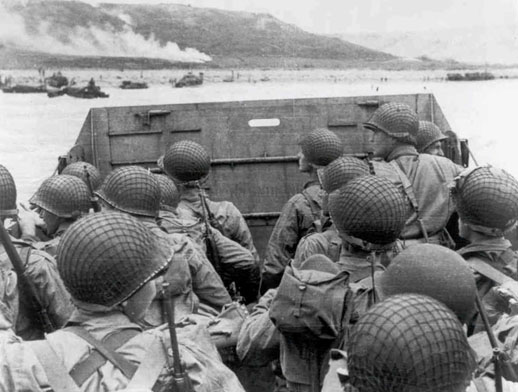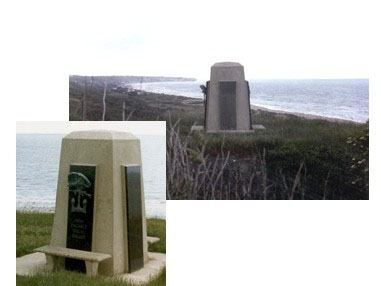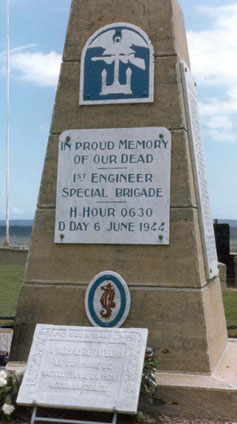Army Engineers Made Key Contributions During the Normandy Landing and Beyond in June 1944
On Memorial Day weekend 2004, the nation dedicated the National World War II Memorial on the Mall in Washington, D.C. The dedication nearly coincided with the 60th anniversary of one of the most dramatic moments in the history of the war—the D-day invasion of France by American and Allied forces.
The western allies had discussed a cross-channel attack from England to northern France for months. Such an invasion would relieve German military pressure on our Russian ally and hasten the demise of Hitler’s regime. But the problems of mounting an invasion were enormous: ferrying thousands of troops and tons of equipment and supplies across the notoriously unpredictable English Channel against heavily fortified German positions on the other side.

American assault troops mass behind the protective front of a landing craft
as it nears a beachhead on the northern coast of France, June 6, 1944
The Allied command assigned two of the five invasion beaches to American forces and code named the beaches Omaha and Utah. Engineer troops played a critical role in the invasion. Engineers would come ashore in the first and most dangerous waves of the landing, clearing the beach of German obstacles, establishing the first dumps of ammunition and supplies, clearing exits through the bluffs and other military and natural barriers behind the beach, and developing roads to allow American troops and equipment to get off the deadly beach and into the interior. Engineers composed 25 percent of the force the Allies planned to land on Omaha on the first day of the invasion.
The landings on Omaha beach were a near disaster. Most American troops landed away from their assigned sections of the beach and encountered withering German resistance. Engineers struggled to remove the beach obstacles that hard-pressed American soldiers had to use as cover. Gradually, in spite of their heavy losses, engineers removed enough obstacles and built enough passable roads to help American troops and equipment land and get off the exposed beach and up the bluff to seize the heavily fortified German bunkers and other positions.
To the west at Utah beach, German resistance was less fierce, and the initial wave of engineers quickly cleared beach obstacles and helped troops move ashore. However, much of the engineers’ heavy equipment did not arrive, making it difficult to build roads through the dunes and exposing troops to German artillery fire. Eventually the engineers cleared roads allowing American troops to move inland.
Despite the doubts and fears of the early hours on Omaha beach, the invasion was a success. Allied forces around the world also were on the offensive in June 1944. Two days before D-day, American forces entered Rome after the hard-fought breakout from the Anzio beachhead. In the Central Pacific, Army and Marine units were preparing for an assault on Saipan. In the Southwest Pacific, Allied forces had almost completed their difficult campaign to seize the northern New Guinea coast in preparation for an invasion of the Philippines. In Burma, engineers were engaged in the difficult and bloody task of completing the Ledo Road as a supply line to China. Although far from over in June 1944, the war’s tide had definitely shifted.
The heroism and sacrifice demonstrated at the D-day landings and in theaters around the world were but a few examples of the heroism and sacrifice of millions of American men and women at home and aboard as they participated in the United States’ largest war. It is this enormous effort and the suffering attending it that the National World War II Memorial commemorates.
 |
|
 |
| Monument to the 5th Engineer Special Brigade with Omaha Beach in the background. Several engineer units erected monuments on Normandy beaches. |
|
Monument to the 1st Engineer Special Brigade on Utah Beach. The French plaque in the foreground reads: "To Our Liberators. The town of Saint Marie du Mont remembers." |
* * *
May 2004